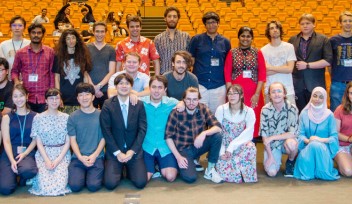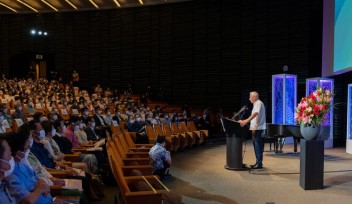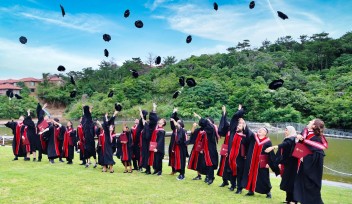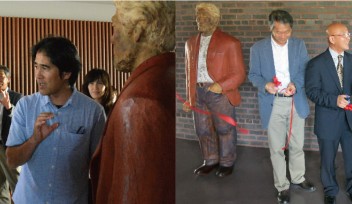In perfect harmony: Science and music unite in OIST’s 10th anniversary concert

At first glance, music and science seem worlds apart. For some, science requires cool logic and analysis, while music and the arts thrive off emotion and creativity. But for many others, the two disciplines go hand in hand. Einstein was a scientific genius but also a passionate violinist, while the lead guitarist of Queen, Brian May, has a PhD in astrophysics.
“Both art and science are crucial in developing new views of our world, to comprehend similarities and differences, to analyze the phenomena of nature and society, and to help interpret them,” said President and CEO of OIST, Dr. Peter Gruss, in a speech that welcomed guests to a concert, held in celebration of OIST’s 10th anniversary. “In order to accomplish the extraordinary, both artists and scientists need to leave the familiar shores behind them and seek the new, unexplored lands. Both groups must be hardworking and disciplined. But what is even more important, is that both rely on creativity and originality.”

Over the last decade, the Okinawa Institute of Science and Technology (OIST) has been building a reputation for creating and sharing cutting-edge, world-leading scientific research. But as the institution heads into the next decade, the merging of science and the arts is a crucial goal that will expand OIST’s cultural impact and provide a source of inspiration and unity for OIST and the local community.
“Music is one of the most universal forms of expression,” emphasized President Gruss. “It provides an enormous and irreplaceable benefit to all of humanity.”
On Saturday May 21, in partnership with the OIST Foundation, OIST paid tribute to this core vision with a one-of-a-kind concert. For the first time in history, four rare and precious violins, built over 300 years ago and worth around US$50 million, were played solo in concert by a single musician.
Three of the violins, built by famous master craftsman, Antonio Stradivari, were provided to OIST by Nippon Violin, while a fourth violin, made by another esteemed crafter, Guarneri Del Gesù, was provided by Dr. Toru Aso, General Director of Tokyo Cosmetic Surgery.

The instruments were played by Eiko Kano, a New York-based, critically acclaimed violinist, who is the dedicated Music Ambassador for the OIST Foundation and Honorary Music Director for OIST. Eiko first became involved with OIST in November 2019, when she was invited to play at the launch event of the OIST Foundation.
“I’m so grateful that I had the chance to do something that nobody has ever done,” said Eiko. “It was definitely exciting, and also challenging. Each violin has its own little idiosyncrasies, so it takes time to build a relationship and get comfortable with them.”
Joining Eiko was her music duo partner of five years, Karén Hakobyan, a renowned harpsichordist, pianist, and composer, along with distinguished musicians from Tokyo and members of the Ryukyu Symphony Orchestra.

Picking the perfect piece of music to play on such priceless instruments may be an agonizing choice for some musicians, but for Eiko, the choice was simple.
“I wanted to pick music around the theme of returning to nature, as it is the mother of all forms of music and science. And once I had chosen that theme, only one piece stood out in my mind. There was really no choice to be made,” said Eiko.
The piece chosen was “The Four Seasons”, the most famous work of Antonio Vivaldi, himself one of the most notable composers of the Baroque period.
Each of the four concertos, representing spring, summer, autumn and winter, was played on a different violin. For Spring, Eiko chose to play “Rainville” – an old ‘friend’ that she had previously been loaned after winning a scholarship at an international competition, that was crafted in 1697 during Stradivari’s “challenging” period. For summer, Eiko played “Beare Steinhardt”, which was crafted by Del Gesù in 1739 during his golden period. Autumn’s concerto was played with “ex-Kavakos” – a late golden era 1724 Strad violin with a strong, focused sound, while winter was taken by Eiko’s favorite instrument, the “Red Diamond” Strad, crafted in 1732 and named for its well-preserved red varnish.

Vivaldi’s “Four Seasons” was revolutionary in its time, as one of the first pieces with a clear narrative, with the music alluding to thunderstorms, bird songs, hunts and slips in the snow. Powerful imagery was also evoked through sonnets that accompanied each concerto, believed to have been written by Vivaldi himself.
For the concert, descriptions of nature from the sheet music were displayed in real-time during the performance, to aid the audience’s understanding of what the music was expressing.
“Usually the audience never gets it see these descriptions – just the players,” said Eiko. “But not everyone is familiar with classical music, and we wanted it to be accessible to all.”
The increased accessibility of music is one of the core visions that Eiko plans to pursue, in her role as OIST's Honorary Music Director.
“I want my role here to be one that connects people, across OIST and the local community, through the power of music,” she said. “And I want to take away the barriers surrounding classical music and science. Both science and classical music are often seen as being up in a high tower – science is only for smart people, or violin is too expensive to learn. I want to expose kids to concerts, so they can gain curiosity and excitement and see it more as a miracle that’s next to them, not far away.”
The first steps towards this goal have been set in motion. Thanks to a major donation from the Ryuji Ueno Foundation, and with the help of Eiko Kano and restorer Yu Takagi, the OIST Foundation was able to donate a 1927 “Golden Era” Steinway Piano to OIST. This world-class instrument will attract elite performers to OIST and play a fundamental role in efforts to connect OIST to the local community through music.

In the future, Eiko also wishes to foster deeper connections with Okinawan musicians.
“Okinawan music is very unique and has a different scale from that used in classical music,” said Eiko. “But we can still learn from each other, what it takes to play the violin, what it takes to be a sanshin player. I’d love to know the history of the music and what it means to them. What kind of music do they play when they are happy, or when they are sad, when they feel joy or pain? Music has always existed an outlet for human emotions.”
Eiko also emphasized that these endeavors are not short-term plans, but instead need to be sustained in over the long-term.
“We are planting this seed now, but we also need to water the seed, and see it through to fruition. And in three, five or ten years’ time, we will hopefully see the impact.”
###
Eiko will be returning to Japan for a fundraising concert on July 30 at the Tokyo Opera City Recital Hall on the theme of connecting music and science. She will play with Tatsuya Daikoku, an Assistant Professor at the University of Tokyo, who specializes in the neuroscience of music. Proceeds from this concert will be used for future activities of the OIST Foundation.
For press enquiries:
Press Inquiry Form













